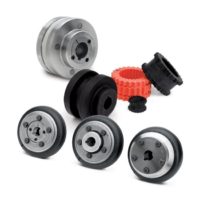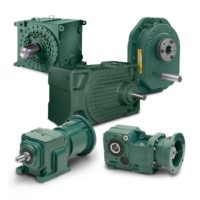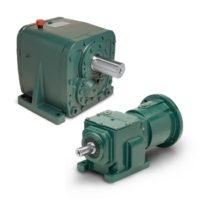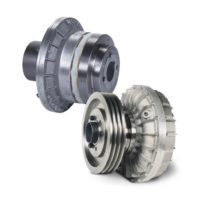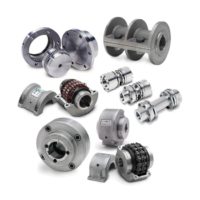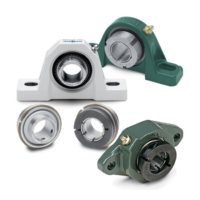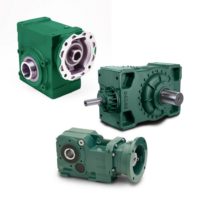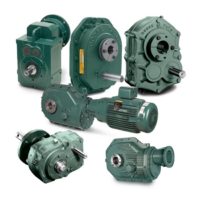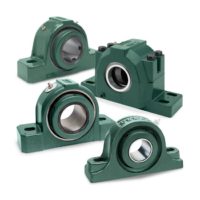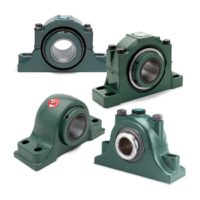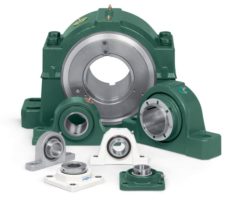
B20-36
ENGINEERING
Plummer Blocks
Sleeve Bearings
SLEEVOIL
Take-Up Frames
Engineering
Part Number Index
Keyword Index
Torque and Horsepower Equivalents
A foot-pound is the amount of energy expended
in lifting a one-pound mass a distance of one foot
against the pull of gravity
FOOT-POUNDS
INDICATE ENERGY
TORQUE
It is: a turning
moment or twisting
effort.
Is it expressed in
foot-pounds? or
pound-feet?
A pound-foot is the moment created by a force of
one pound applied to the end of a lever arm one
POUND-FEET
INDICATE TORQUE
Example:
25 HP at 150 RPM = 10504 Pound-Inches Torque
2.5 HP at 150 RPM = 1050.4 Pound-Inches Torque
For other values of RPM move decimal point in RPM values to the left or
right as desired, and in Torque values move to the right or left (opposite
way) the same number of places.
Example:
25 HP at 150 RPM = 10504 Pound-Inches Torque
25 HP at 1.50 RPM = 1050400 Pound-Inches Torque
2.5 HP at 1.50 RPM = 105040 Pound-Inches Torque
Force = Working Load in Pounds.
FPM = Feet Per Minute.
RPM = Revolutions Per Minute.
Lever Arm = Distance from the Force to the center of rotation in Inches
or Feet.
HORSEPOWER
Common Unit of Mechanical
power - (HP)
One HP is the rate of work
required to raise 33,000 pounds
one foot in one minute
An overhung load is a bending force imposed on a shaft due to
the torque transmitted by V-drives, chain drives and other power
transmission devices, other than flexible couplings.
Most motor and reducer manufacturers list the maximum values
allowable for overhung loads. It is desirable that these figures be
compared with the load actually imposed by the connected drive.
Overhung loads may be calculated as follows:
O.H.L.
=
63,000 X HP X F
N X R
Where HP
=
Transmitted hp X service factor
N
=
RPM of shaft
R
=
Radius of sprocket, pulley. etc. (inches)
F
=
Factor (See chart to right)
Weights of the drive components are usually negligible. The formula is
based on the assumption that the load is applied at a point equal to one
shaft diameter from the bearing face. Factor F depends on the type of
drive used:
1.00 for single chain drives.
1.3 for TIMING Belt Drives and Sync belt Drives.
1.25 for spur or helical gear or double chain drives.
1.50 for V-belt drives.
2.50 for flat belt drives.
Example: Find the overhung load imposed on a reducer by a double
chain drive transmitting 7 hp @ 30 RPM. The pitch diameter of the
sprocket is 10”; service factor is 1.3.
Solution:
O.H.L. = (63,000) (7 x 1.3) (1.25)
= 4,780 lbs.
(30) (5)
To find circumference of a circle, multiply diameter by 3.1416.
To find diameter of a circle, multiply circumference by .31831.
To find area of a circle, multiply square of diameter by .7854.
To find area of a rectangle, multiply length by breadth.
To find area of a triangle, multiply base by 1/2 perpendicular height.
To find area of ellipse, multiply product of both diameters by .7854.
To find area of parallelogram, multiply base by altitude.
To find side of an inscribed square, multiply diameter by 0.7071 or
multiply circumference by 0.2251 or divide circumference by 4.4428.
To find side of inscribed cube, multiply radius of sphere by 1.1547.
To find side of an equal square, multiply diameter by .8862.
To find the surface of a sphere, square the diameter and multiply by
3.1416.
找到一个球体的体积,立方体的直径nd multiply by .5236.
A side of a square multiplied by 1.4142 equals diameter of its
circumscribing circle.
A side of a square multiplied by 4.443 equals circumference of its
circumscribing circle.
Mathematical Equations
{
F=
Torque (in Pound-Inches)
=
=
Torque (in Pound-Feet)
=
=
63025 X HP
RPM
Force X Lever Arm (In Inches)
5252 X HP
RPM
Force X Lever Arm (In Feet)
Overhung Loads



